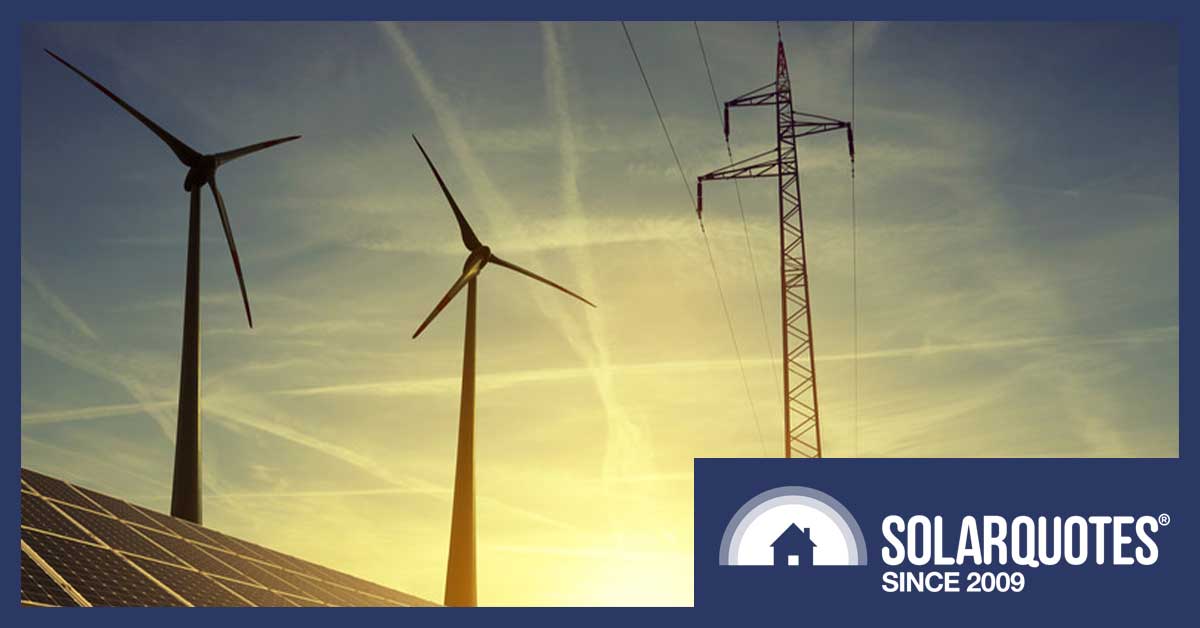
Electricity Prices To Fall Thanks To Wind And Solar Power — But Not In WA!
If you don’t live in Western Australia I have good news. A report released on December the 9th by the Australian Energy Market Commission (AEMC) says electricity prices will fall in all states except WA.
Over the next two and a half years the national decrease in household electricity bills is estimated to be 7.1%. This won’t be evenly spread and will range from a large decline in Queensland to to a kick in the pants in Western Australia. From best to the worst, the expected reduction in residential electricity bills over the next 2.5 years are:
- Queensland 19.5% lower
- NSW 8.3% lower
- ACT 6.9% lower
- Tasmania 4.9% lower
- Victoria 4.6% lower
- South Australia 1.5% lower
- Western Australia 6.4% higher
The main reason electricity will be cheaper for everyone east of Eucla is increasing renewable energy capacity. Solar farms, wind farms, and rooftop solar power all help drive down wholesale electricity prices and lower wholesale prices will be responsible for almost two-thirds of the predicted decline in electricity bills.
Unfortunately, the report is not all good news:
- Lower wholesale prices will lower solar feed-in tariffs.
- We may have to wait until next financial year for bills to fall.
- The predictions don’t take inflation into account, so for many people electricity prices will appear to, more or less, hold steady.
- Western Australians get screwed over on electricity costs again.
The Big Picture — As Big As Australia
This graph from the report shows the expected fall in residential electricity bills for all of Australia, excluding the Northern Territory – which was left out because wholesale electricity prices there are secret:1
As you can see, they don’t expect any bill decrease this financial year, and most of the decline will happen in 2020/21.
The graph is broken into four components:
- Residual: This is mostly retailing costs, which covers billing and customer inquiries.
- Environmental Policies: Federal and state policies designed to protect our health and the environment.
- Regulated Networks: Long distance transmission and the local distribution of electricity.
- Wholesale: What generators get paid for providing electricity.
As you can see by eyeballing the graph above, most of the fall in electricity bills will come from lower wholesale electricity prices. If you want to see a more detailed breakdown you have two choices:
- Go to page 5 of the report and stare in horror at a cluttered table, or…
- Look below at my sleek and simplified version of their table, which is a technicolour wonder to behold.
I figured the easiest way to indicate what will happen over the next two to three years is to show how much each component of an electricity bills is expected to change and what percentage point change in electricity bills this will cause:
On this table environmental policies and regulated networks are broken into their components and I’ll provice some details on them below. Looking at the left column we can see the biggest money savers are:
- Lower Wholesale prices: 4.6% decrease in electricity bills
- Lower LRET or Large-scale Renewable Energy Target costs: 1.6% decrease in electricity bills
- Lower Distribution costs: 0.6% decrease in electricity bills
- Lower Metering costs: 0.4% decrease in electricity bills
The only appreciable increase is from:
- Higher Transmission costs: 0.3% increase in electricity bills
Lower Wholesale Prices
Wholesale electricity prices have been exceptionally high in Australia over the past four years, as this table from the Australian Energy Market Operator shows:
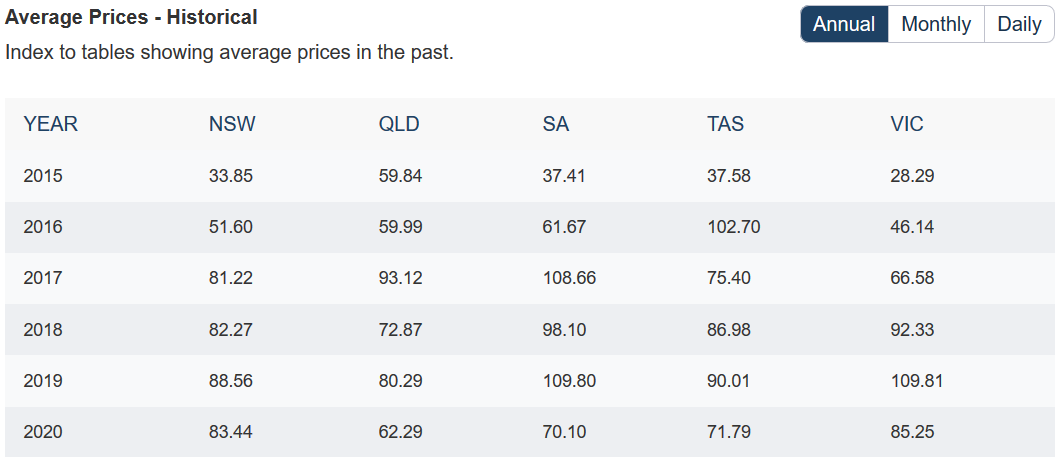
This table shows the wholesale electricity market spot price in dollars per megawatt-hour. To get cents per kilowatt-hour just divide by 10. Note the figures for 2020 are only from the first two weeks of the year. (Image Source: AEMO)
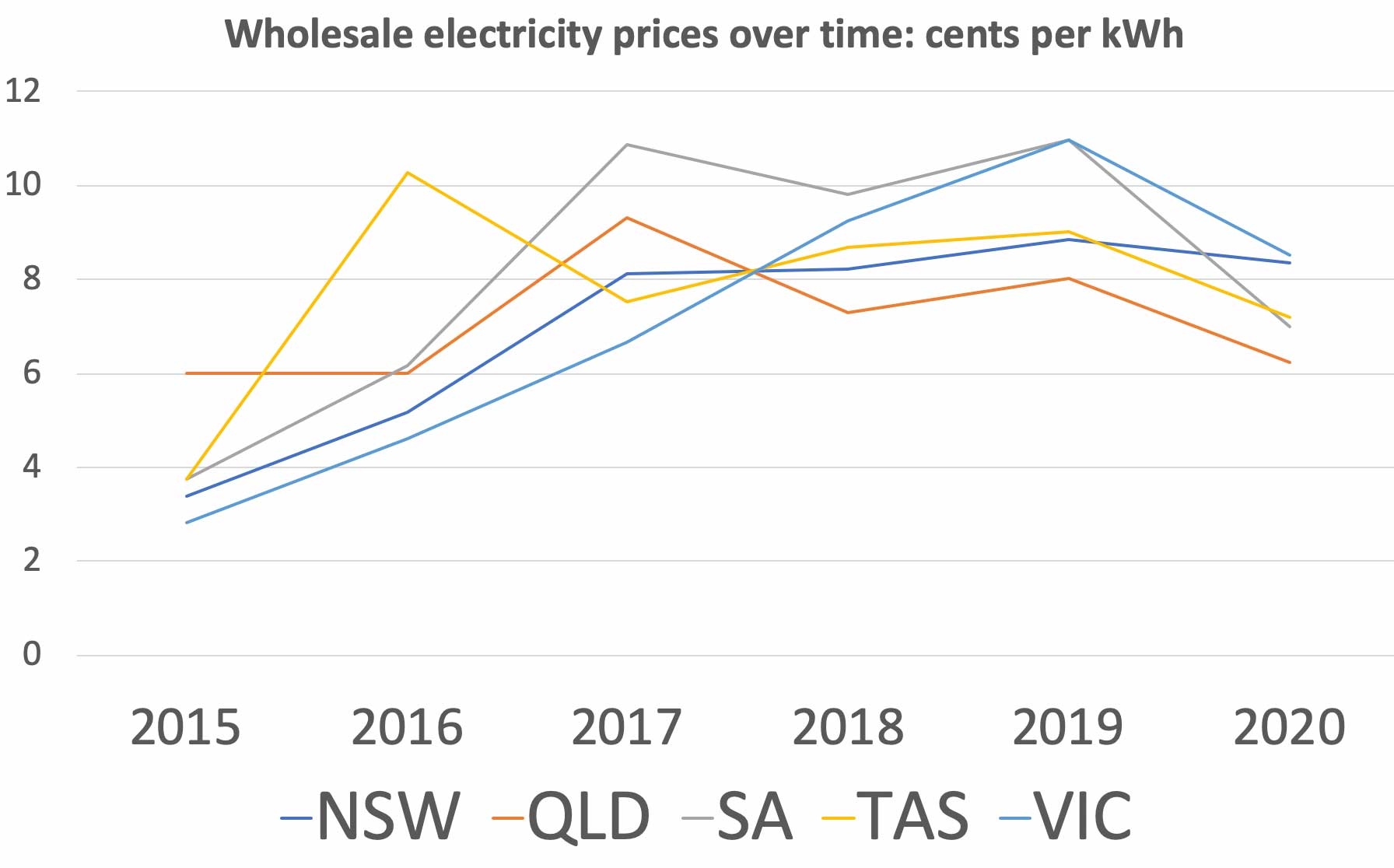
I turned it into a graph so it is easier to digest. You’re welcome.
As you can see, Australians back in 2015 were living in a dreamworld and only paying an average wholesale electricity price of around 4 cents per kilowatt-hour. That’s quite a difference from 2019 where the average was roughly 9.4 cents.
There were a number of reasons why wholesale electricity prices soared:
- Abbott Government opposition to renewable energy slowed its expansion.
- The completion of natural gas export facilities near Gladstone caused natural gas prices on the east coast to more than double as they approached international prices.
- But mainly, Australia’s oversupply of generating capacity ended, as 22% of the nation’s coal generating capacity has been shut down since 2012.
Things are looking a little better now:
- Despite our current Prime Minister’s penchant for waltzing around Parliament with a lump of coal, the Coalition is not as rabidly anti-renewable as under Abbott, so that’s something.
- Natural gas prices overseas are relatively low at the moment.
- Most importantly, we’ve had a surge in large scale renewable energy construction. The AEMR report gives the total capacity of committed projects as 2,338 megawatts of solar power and 2,566 megawatts of wind energy.
- Record amounts of rooftop solar are being installed.
- In addition to new renewable capacity, there will also be 210 megawatts of open cycle gas turbines built. These are gas generators that are usually only used when wholesale electricity prices are high, such as during heat waves, because of their high fuel use.2
AEMC’s Wholesale Figures Don’t Match The AEMO’s
The AEMC report gives figures from the 2018/19 financial year that aren’t predictions and based on actual prices. However, they differ from the from the average wholesale prices the Australian Energy Market Operator (AEMO) provides. Since the AEMO is responsible for running the electricity market, I’m pretty sure their figures are correct.
The table below compares AEMC and AEMO average wholesale electricity prices3 for the eastern states in cents per kilowatt-hour:
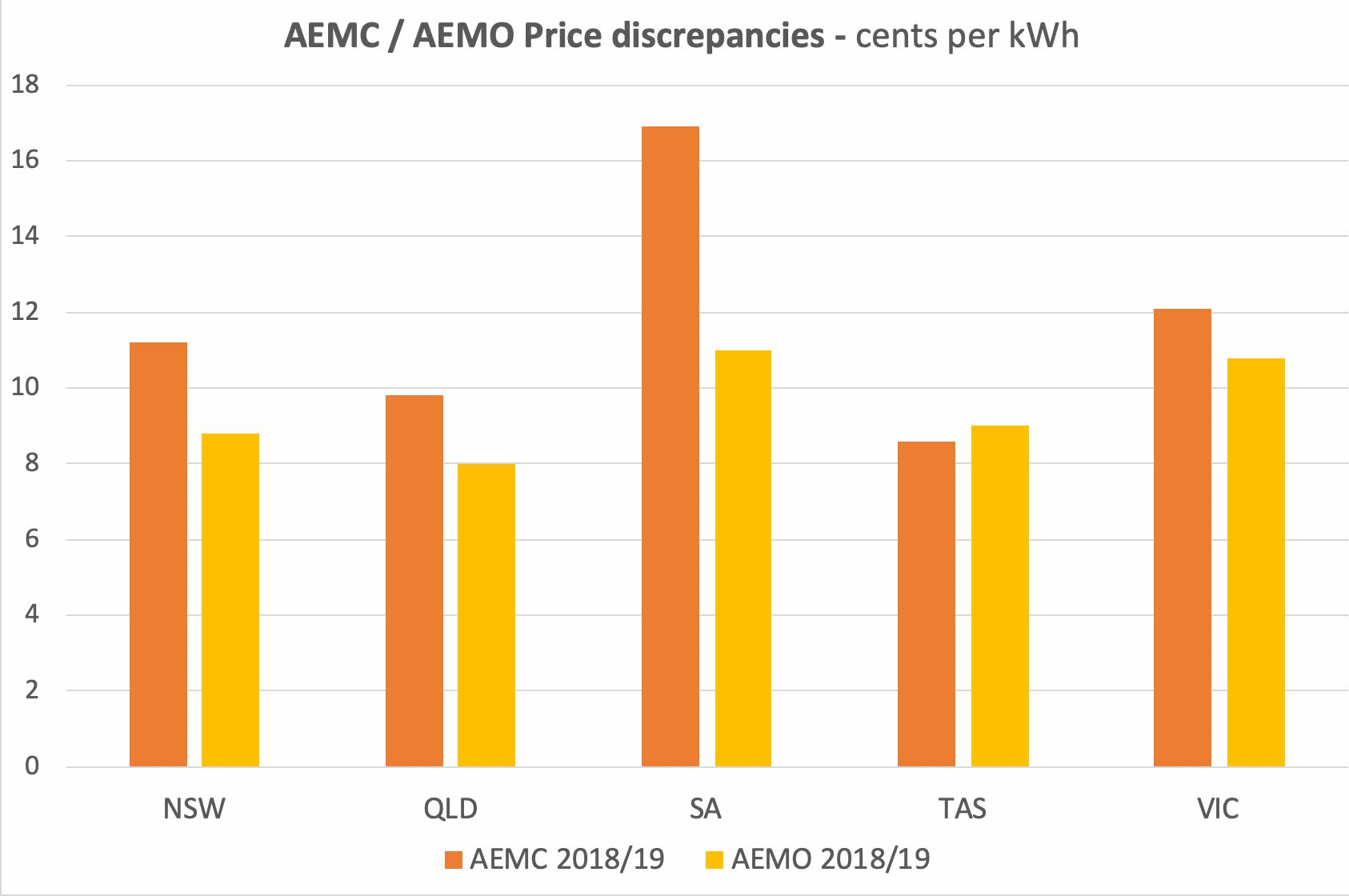
You are welcome (again).
The AEMC report says they model wholesale prices, so I can understand some discrepancy. But their figure for South Australia is 54% higher than the AEMO’s and that’s really got me scratching my head over how they arrived at that amount. If the AEMC could provide a brief explanation in future reports that would be helpful. It would also — hopefully — give me more confidence in their results.
Renewables Lower Wholesale Prices
New renewable generating capacity lowers the wholesale price of electricity in two main ways ways:
- Firstly, new renewable capacity is cheaper than new fossil fuel capacity. This is true even though wind and solar power need to be firmed by dispatchable sources of energy that can be turned on and off as needed.
- Secondly, solar and wind have zero fuel cost4 and so, unlike fossil fuel generators, they save nothing by withholding supply. This makes them more likely to provide all the energy they can generate to the market. Not only are renewable generators less likely to play the market to raise prices, they make it difficult for other generators to do the same, helping to lower the cost of electricity from all sources.
This means renewable energy benefits Australians in three main ways:
- Contributes to a safer environment with a less unstable climate.
- Better health thanks to lower air pollution.
- Lower electricity prices.
Hopefully the rate at which large scale solar and wind farms are built won’t dramatically decline as the government allows all support for renewable energy to end.
Our Government Is Allowing The LRET To Disappear
Australia has a Large-scale Renewable Energy Target, called LRET for short. The Abbott Government cut it by 20% but it is still around and is responsible for the current mini-boom in large scale renewable construction. The LRET is being phased out and will end entirely in 2030. But this won’t be a gradual decline and support is expected to drop rapidly. The table below shows future market prices for Large-scale Generation Certificates or LGCs that are part of the LRET:
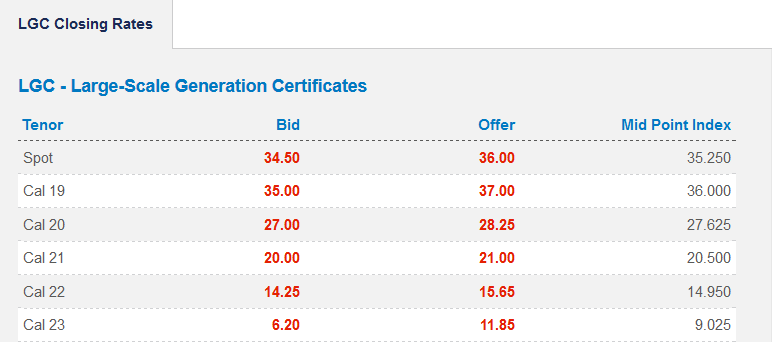
Image Source: Mecari
In calendar year 2023 they are predicted to fall to $11.85 per megawatt-hour. That’s around 1.2 cents per kilowatt-hour.
At the moment around 2.6% of household electricity bills goes towards the LRET. By the 2021/22 financial year it is expected to be 1%. This fall in the cost of the LRET will result in the second largest drop in electricity bills after lower wholesale prices.
As there is no Federal Government support for large scale renewable energy other than the LRET, there may be a large decline in its construction at the end of this year. I’m hoping the costs of renewable energy will have fallen enough by then that there won’t be a severe drop. But be warned, I’ve been told reality doesn’t actually pay a great deal of attention to my personal hopes. The good news is a considerable number of projects look like they will be going ahead over the next few years.
While the LRET raises electricity bills, we’re better off with it. This is because by lowering pollution and greenhouse gas emission from fossil fuel generation, it lowers health costs and the costs of environmental damage.
A Lot Of Rooftop Solar Will Be Installed
Rooftop solar receives a subsidy that is often called the “solar rebate“. It’s real name is the Small-scale Renewable Energy Scheme or SRES for short. Last year when rooftop solar capacity was installed at record levels, it added around 2.3% to electricity bills. This is expected to fall by 9% in 2021/22.
This is an interesting prediction because the SRES is being phased out and the amount received per kilowatt of rooftop solar installed will fall by 25% by 2022 compared to 2019. This means the AEMC is expecting a considerable expansion in the amount of rooftop solar installed over the next few years on top of the record set last year.
Rooftop solar panels provide the same benefits as large scale renewables and helps lower wholesale electricity prices, so it not only lowers electricity bills for homes that have it but for everyone else as well. The cost of the Small-scale Renewable Energy Target also raises electricity bills by 2%. While this makes some people who can’t install rooftop solar grumpy, considering the health and environmental costs of sticking with coal and natural gas, it’s a bargain.
Long Distance Transmission Costs Heading Up
Increased costs of long distance transmission are estimated to increase electricity bills by 0.3%. This is the cost of building and maintaining the high voltage transmission lines that carry current from large scale generators to towns and suburbs.
How much of this increase is due to new transmission lines isn’t made clear. While new transmission will increase this component of electricity bills, it can lower wholesale electricity prices in two ways:
- By allowing increased arbitrage – moving electricity from where it’s cheap to where it’s more expensive — and…
- By increasing competition between generators.
So paying for new long distance transmission can definitely be worthwhile. On the other hand, there is the possibility if renewable energy and battery costs fall fast enough, expensive new long distance transmission capacity will turn out to be a waste of money.5
Local Distribution Costs Coming Down
Electricity is taken from long distance transmission lines and provided to local homes and businesses by Distributed Network Service Providers.6 The cost of local distribution is expected to fall by just 1%. But, because this is such a large component of electricity bills, it’s enough to lower electricity bills by 0.6%. This puts it in third place for cost decreases after lower wholesale prices and reduced LRET.
Metering Costs To Fall
The cost of reading electricity meters is expected to fall by almost 14%. That’s a hefty decrease, but because metering is a small component of electricity bills, it will only lower them by 0.4%.
Metering costs should definitely be falling, as every new meter is now required to be a smart meter7, which saves costs by regularly transmitting information rather than paying someone to come around and read it. It also eliminates the need for many service calls. The most common reason for replacing an electricity meter is because rooftop solar panels have been installed, so solar energy is helping drive cost reductions here.
Queenslanders Are Biggest Winners
Electricity bills are expected to fall by 19.5% in Queensland, which puts the Sunshine State way out in front. A major reason is new renewable capacity in the state, which is expected to total 595 megawatts of solar farms and 496 megawatts of wind power over the next two and a half years. In addition, Queensland has the most rooftop solar in the country and the AEMC expects its installation rate to increase. However, unlike other states and the ACT, both lower local distribution costs and lower retailing costs will provide more relief on electricity bills than lower wholesale prices.
The AEMC makes it clear their estimate is is only for the Energex network area in South East Queensland. However, regional Queensland — the Ergon network — should see similar electricity bill declines.
Western Australians Screwed Over Again
The unfortunate losers in the game of electricity bills are Western Australians. Rather than seeing a decrease like other states, their electricity bills are expected to increase by 6.4%. This will mostly be due to expected increases in the cost of gas in the Western Australian market. The AEMC does not think expanding renewable capacity in WA will be enough to offset this increase.
This is especially bad news as the state has already suffered significant electricity bill hikes, including increased burdens on lower income households. Normal Western Australians are paying high prices for electricity despite their state government subsidising it by around 10 cents per kilowatt-hour.
Solar Feed-In Tariffs Likely To Fall
While the AEMC report doesn’t go into solar feed-in tariffs, any decrease in wholesale electricity prices is going to put downward pressure on solar feed-in tariffs. Overall, wholesale electricity prices are expected to fall by 1.45 cents. In the states and the ACT the predicted change per kilowatt-hour is:
- ACT: 1.7 cent decrease
- NSW: 1.7 cent decrease
- Queensland: 1.2 cent decrease
- South Australia: 1.7 cent decrease
- Tasmania: 0.9 cent decrease
- Victoria: 2.0 cent decrease
- Western Australia: 1.1 cent increase
But this is the fall in average wholesale prices. As more rooftop solar panels are installed and solar farms are built they are likely to fall by more during the day than at night. The effect won’t be dramatic over the next few years because it will result in more consumption shifting to the daytime to take advantage of lower prices. But people in the eastern states can probably expect a fall in solar feed-in tariffs of around 2 cents or possibly more, over the next two to three years.
Western Australians should receive an increase in feed-in tariffs, but according to AEMC figures8 people in WA are already getting ripped off and receiving a feed-in tariff considerably less than the wholesale electricity price, so it’s possible Western Australians will just become more ripped off.
Some Caveats, Provisos And Cautions
The AEMC report makes it very clear they are just providing estimates using a model and they’re not providing a guarantee that anyone’s electricity bill will decrease or increase by any particular amount. They are really serious about this, so I can only guess someone’s granny rang them up at some point and gave them a real earful about an erroneous prediction of theirs.
Their model also only calculates results for a typical household. While Australia’s average household size is 2.6 people, the most common household size is 2 and that is what the AEMC uses for their modeling. While it shouldn’t make a large difference, this could alter results if your electricity consumption is particularly high or low.
The AEMC is also up front about getting predictions wrong in the past. But looking at their past mea culpas they really don’t have anything to be ashamed of. Prediction is very difficult, especially when it comes to the future. I’d say the AEMC report is probably the best thing we have to go on.
Our Tool Can Help You Pick The Best Electricity Plan
Whatever happens to electricity prices, if you are in South East Queensland, NSW, Victoria, or South Australia I’m afraid you have retailer choice. This means you will have to fight to get the best retail electricity plan. Fortunately, SolarQuotes has a very useful tool that can help you. He writes blog posts.
We also have another very useful tool that can help you select the best electricity plan. It’s a work in progress and we’re still figuring out how to prevent electricity retailers from gaming the system, but it can help you find a plan that is likely to be best for you.
And remember, just like the devil, it is possible to bargain with electricity retailers and ask for a better deal. The chance of success is probably less than when dealing with the devil, but that doesn’t mean it’s not worth trying.
Footnotes
- Seriously, this is the reason the report gives for not including the Northern Territory. It just explains it using bigger words than I did. ↩
- An open cycle gas turbine (OCGT) may use up to twice as much gas per kilowatt-hour generated as a combined cycle gas turbine (CCGT) such as Pelican Point Power Station. ↩
- Because the AEMO doesn’t give average prices for financial years, the figures I used may be slightly inaccurate, but they should be close. ↩
- Wind power could be said to have a very small fuel cost of a fraction of a cent due to wear and tear on the wind turbines, while solar power has an even smaller fuel cost due to wear and tear. However, a solar panel that’s being used to generate electricity may last longer than one that isn’t. This is because a portion of the light energy hitting a panel in use becomes electrical energy instead of heat and so it won’t get as hot. ↩
- The current South Australian government campaigned on subsidising home battery storage and building and new transmission capacity. They didn’t seem the slightest bit aware their policies were at cross purposes. ↩
- Rooftop solar also makes use of local poles and wires. Nearly all energy from rooftop solar panels is consumed locally and so doesn’t need to make use of long distance transmission lines or local transformers. This will gradually change as rooftop solar capacity increases and the grid is upgraded. ↩
- It is possible to opt out, but they will make you pay through the nose for it. ↩
- According to AEMC figures the WA wholesale price was 12.3 cents per kilowatt-hour in 2017/18 and it will be 15.5 cents in 2021/22. ↩

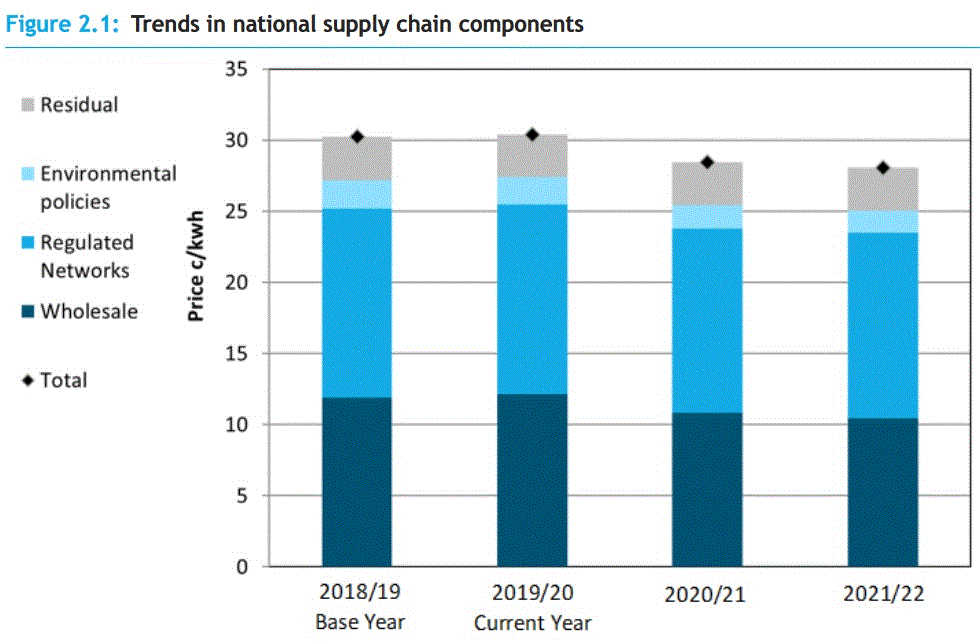
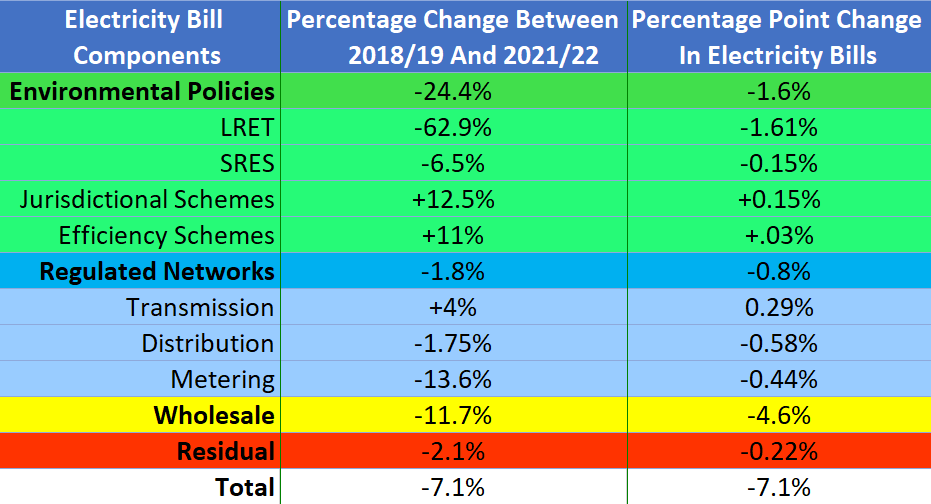


 RSS - Posts
RSS - Posts



Considering how much electricity has gone up over the last 10 years these figures are nothing to get excited about for me in SA. I still pay almost double what someone in Queensland does and I need a lot more heating and cooling than most of them.
We are all still getting scammed through the government selling out Australia from under us and cheaper battery tech is the only way to escape it.
Yer right, electricity prices to fall. Heard that one before. I’m still waiting for Aborts $500 better off BS. The wholesale RE market investment is about to collapse, what with the obstruction of the very same AEMC to how RE projects transmission losses are calculated and the total connection fiasco not to mention Scumo and Anxious Taylor, then if you believe prices are going to fall then all I can say is don’t spend it all at once.
“……Victorian prices to fall 4.6%…” sorry chaps the Victorian Default rate just went up 2 cents a KWH from the 1st January 2020…the Essential Services Commission has flagged a decrease in the feed in Tariff from 12 to 10 cents come 1 July 2020. Spruking miserable price drops like these ahead time simply invites the foreign controlled power industry to hop on the lobby train and screw again some how,
Direct quote from article:
“We may have to wait until next financial year for bills to fall.”
Your article did not mention prices rising again before falling next year, thereby resulting in no fall at all. And since when have wholesale price drops ever benefited households! It’s what margins retailers wish to maintain! You sound exactly like a politician. Some piddling price drop which never eventuates is supposed to make us drop to our knees and give thanks!..We will never win that battle in an uncompetitive privatised market. All States have constitutional powers to control prices, but they sold off the utilities (or will do or use the wholesale bs market as an excuse) and guaranteed certain levels of return to Power Companies allowing them to do as they like.
That’s a fair cop. From now on, instead of reporting what the AEMC says, I’ll use magic powers to determine what future electricity prices will be.
“Western Australians get screwed over on electricity costs again.”
How true.
The McGowan Labor government has always viewed the LNP’s FiT rebates as ‘middle class welfare’. It’s therefore extraordinary that they’ve chosen to refuse tenants* FiT rebates on rentals which have solar panels and 10-year-contracts.
I’m still working on behalf of one young woman owed 20 months’ FiT rebate.
My efforts have been rewarded with long periods-on-hold (up to 77 minutes); continual delays (call us in 2 days, call us in 2 days, call us in ten days, we’ll call you in X days, etc.) When tenants are eventually paid, they’re given a percentage of what is owed them. These tenants aren’t always able to meet their electricity bills. One single mum with four kids was on a payment plan owing over $860… without having received one single cent of 30 months’ FiT!
I’ve documented all this… and I’m losing patience with this state-owned utility.
They’re losing patience with me, too. They refused to pay me MY Fit; then paid it; then clawed it back… then OVERpaid it! Unbelievable… .
* To be fair, three male tenants _have_ all been paid their FiT since 2017. Seven _regional_ female tenants have been declined. “Just coincidence!” says Synergy. Those seven women all _needed_ that FiT rebate: shop assistants, teacher aides, single mums, unwaged housewives, etc.
Ron what has happened to your hard hitting investigative journalistic flair and obsession for the truth?
You have turned turtle.
Your headline was great:- AEMC Report — Electricity Prices To Fall Thanks To Renewable Energy.
All that followed though was akin to a first year apprentice trying to fit a square peg in a round hole.
All of the mumbo jumbo mathematics; voodoo logic; and manipulations and conditionals [if A then B else C etc] just doesn’t cut it.
You had to much brandy custard on your Xmas pudding and its still affecting you.
Please revert to how you used to be in evaluating truth in all things, and express the results in simple terms.
Lawrence Coomber
So these ‘falls’ in power prices have nothing whatsoever to do with anything the coalition have done but everything to do with people and companies being proactive and getting on with job? Makes you wonder why we pay politicians.
You reported recently about Energy Australia dropping their FiT by ~30% so it would be nice to see an almost 20% drop in supply tariff too but I really don’t plan on holding my breath waiting for it. I’m sure some of that 20% will get lost in some complex calculations, paying for focus groups and overseas trips to find all new ways of shafting the public from foreign entities (I hear electricity is very interesting in the Caribbean this time of year). And that’s even before ScoMo comes up with a clever scheme to tax renewables to pay for his poor coal loving mates.
Well…. our electricity ‘usage’ rate per kwh may possibly fall, however we could well face some ‘new’ fixed charges as a result of the outlays required to replace/repair sections of ‘completely burnt to ashes’ grid. e.g some kind of ‘levy’ that applies for 5 years or so.
All in all, it seems to me, there’s about as much chance of a decrease in our OVERALL electricity bills as there is of seeing a dozen one-eared pigs clutching silk purses, flying through the night sky. (excuse me for mixing multiple metaphorical sayings)
Protesting, while wearing ‘Down with Dutton’ tee-shirts, or waving placards that read ‘Scomo for Disneyland CEO. Send him there NOW! ‘ probably won’t get us anywhere either.
Here is a link to a letter in the Canberra Times, written by a person on the South Coast, who expresses very well the thoughts in the minds of many of those who’ve lost their homes recently.
https://www.canberratimes.com.au/story/6580719/i-lost-my-home-in-the-south-coast-bushfires-heres-what-id-say-to-the-pm/?cs=14329
You might need to scroll down a bit while reading – the Canberra Times has an annoying habit of inserting a links to other pages under the heading ‘Read More’, before the end of the article is reached.
Speaking of solar FiT, I wonder if a the distribution charges (DUOS) also influences these? The logic would be that if retailers with FiT customers are charged the DUOS for any electricity fed back into the network, then this becomes part of the cost to a retailer of electricity sourced from rooftop solar. Thus any decrease in DUOS may increase the FiT a retailer is willing to pay.
My understanding is retailers take the solar export figures from solar household’s meters and claim back the DUOS from Distributed Network Service providers.
I can’t wait for cheaper rates. Ronald has there been a recent increase in off peak rates in Vic? my recent Jan 1st increase was
Peak +7%, Shoulder +26%, OffPeak +70%
as I am an electric HWS household my electricity bill is set to increase by $1100 per annum on just off peak alone!
I had a look on the govt comparison page and I can’t find rates like my old ones anywhere..
Looking at currently available retail electricity plans in Victoria I can see off-peak rates have increased across the board from the last time I checked. It’s hard to believe it was possible to get a controlled load in Victoria for only around 4 cents per kilowatt-hour only a few years ago.
Last year wholesale electricity prices in Victoria averaged the highest they have ever been. Part of this has been due to the horrible state of the Loy Yang Power Station which had 560 megawatts of capacity under repair for months and only just got it working again on Christmas Eve but then had to shut it down again a few days later. I presume the increase in off-peak rates is a way to raise bills in a way they hope is less likely to be noticed.
For the …..um … second or (or third?) time:- Get yourself a suitable STAND-ALONE solar system ~ and DON’T tell them. All dirt cheap so long as you don’t expose yourself to the ‘sunlight tax’ which is no doubt on the way.
THEN send your ‘povider’ a bill for the storage of HIS cable, insulators, meter-box etc. on YOUR property..
NOTE:- The ONLY good thing about being “an electric HWS household” is that you can change the way you do things. Sol doesn’t only provide electrical energy; he also provides solar heating (with as many ancillary frills as you like.
funny I live in SA and just got a letter from my retailer saying their prices are goind up 5%!
Yes renewables are cheaper but the bigger question is does this translate into lower electricity prices. Solar is only good when the sun shines and wind only when the wind blows, which gives wind farms about a 30% capacity factor. So behind the scenes to keep the lights on are gas powered generators which need to be paid for – so I am now paying for nearly twice the generation capacity I used to but can feel good about it because there are less CO2 emissions .
If you are not a true believer this is distasteful compromise.
Yep – similar problem here in NSW. I have just received a letter from EA advising my rates are about to go up – only around 1.6 – 1.7%, but still…
I am currently in dispute with my insurance company over serious hail damage to my (tiled) roof, but as soon as I can resolve that (13 months and counting!) Colorbond roof, here we come, followed very rapidly by PV panels and a replacement for my 40 year old Solahart hot water system. (Yep – smashed to bits by hail but still working – just not very efficiently. I don’t think they build ’em like that any more.)
Hi Peter
We can be certain more renewable generation translates into lower electricity prices because electricity is sold in a market. If it was cheaper to use coal and gas then coal and gas would be used instead. The 2.6% of household electricity bills that goes towards the LRET has helped increased Australia’s large scale renewable generation to its current 25% of grid consumption, but — as the article mentions — its support will phase out rapidly. If renewable generation is not cost effective then its construction should slow and stop as support is withdrawn and new coal and gas generating capacity will be built instead. No one is predicting this will happen. Not without heavy subsidies for fossil fuels.
The LRET has helped to shutdown 22% of Australia’s coal capacity over the past 8 years. Last year domestic coal consumption was down 21% from its 2007/08 peak. That represents a large decrease in fossil fuel generating capacity and a large decrease in air pollution and resulting health costs. From the point of view of human health and happiness that’s a big plus.
Don’t be too hopeful. It seems to me that its far more likely we’ll still end up subsidizing uneconomic coal stations with huge amounts of money
According to this article on SBS: “More than 80 per cent of Australian business leaders believe now is the time to act on climate change”
See: https://www.sbs.com.au/news/more-than-80-per-cent-of-australian-business-leaders-believe-now-is-the-time-to-act-on-climate-change
However, before we too excited about that, further down the article says:
“It found 81 per cent of Australian business leaders believe climate change will have negative consequences for their businesses, well above the global average of 48 per cent.
While 83 per cent said it was their generation’s responsibility to address climate change, only half as many were prepared to invest in new technologies to counteract the effects of climate change.”
The bottom line of that is: we still have around 58% of all businesses who either don’t believe climate change exists at all, or if it does, still can’t be bothered doing anything about it.
Those results are somewhat similar to the results of the January poll ‘Climate change concern and attitude’ carried out while the bush-fires were occurring. There were only1033 participants in that poll though, and that’s not really a large enough sample.
But just the same, while you have around 70% of the people expressing ‘concern’ only around 45% of those expressed ‘strong concern’ and felt that the Government needed to take strong action NOW.
By inference, that poll suggests that some 55% of the Australian population either don’t believe climate change exists, or even if it does, aren’t willing to do much about it.
The two separate survey and poll results show pretty much the same thing overall. Which is not so surprising really.
So long as ‘denialism’ in its many forms continues to hold such sway in the thinking of the general population, I’m suggesting that a ‘switch’ to renewables will not occur as swiftly as is needed, nor as smoothly as it should.
An as yet little considered factor is the ‘flow-on’ economic effects from other countries on Australia. As their economies slow, or get hugely disrupted, this will eventually affect our international trade, in all kinds of unexpected ways. Most of those effects are likely to be detrimental.
A ‘slow canter to nowhere’ still seems pretty much on the cards to me.
Des Scahill,
You state:
“An as yet little considered factor is the ‘flow-on’ economic effects from other countries on Australia. As their economies slow, or get hugely disrupted, this will eventually affect our international trade, in all kinds of unexpected ways. Most of those effects are likely to be detrimental.”
One of those factors I see will likely be whether global oil production will continue to meet demand. At the moment it seems some of the oil majors are living beyond their means – I’d suggest this is a prelude to a global oil supply crunch coming.
See: https://ieefa.org/ieefa-report-oil-majors-live-beyond-their-means-%e2%80%92-cant-pay-for-dividends-buybacks/
Also: https://ieefa.org/ieefa-update-the-terrible-horrible-no-good-very-bad-year-for-oil-and-gas/
Disrupted/declining oil supplies means disrupted/declining international trade, unless we find affordable, rapidly deployable at large-scale alternatives to petroleum.
The writing has been on the wall, yet few see it, and many deny it as they sleep-walk off the ‘energy cliff’.
Couldn’t agree more Des. I believe some energy companies (BP which has rebranded as Beyond Petroleum – go figure) have made the first tentative steps by investing heavily in EV chargers in Europe and the UK where legislation supports the uptake of EVs. But of course the bulk of their revenue comes from oil and gas.
As we import nearly all of our diesel and petrol it’s also makes sense for the Aust govt to start setting policies to encourage the uptake of EVs on three fronts.
1. it will greatly benefit our balance of trade as nearly all electricity is locally sourced resources.
2. It will enhance our energy security situation which is currently a diabolical mess.
https://reneweconomy.com.au/podcast/the-driven-podcast-evs-range-anxiety-and-fuel-security/
3. It will stimulate new car sales and hence the economy in a market which is currently “tanking” for petrol and diesel vehicles.
John Australian reticulated power supply is the most expensive in the world, and that is nothing to be proud of.
How is this situation then conducive to Government being coaxed from the sidelines to spend taxpayers funds supporting and subsidising the charging of EV batteries with high priced electricity for a privileged minority.
Governments focus should be elsewhere. The miniscule EV industry is a long way down the list of meaningful priorities for Governments everywhere.
A more accurate interpretation of your idea John should have read:- “Australian taxpayers should cough up to support the small percentage of those Australians who can afford to purchase an EV to do so”.
Move your mind away from this nonsensical subsidy driven epidemic John that Australia finds itself in at every turn. We can do much better than continue to set very low bars of corporate achievement in most categories [such as your shipping container led EV revolution + taxpayer support] and insisting we are still a modern; capable and visionary society.
Lawrence Coomber
Ron fair criticisms have been raised in this subject.
Heaven help us if we all get ground down to becoming accepting of ways and means just because they have become commonplace and seemingly mainstream through overexposure..
Just because something is doesn’t justify timid and sycophantic acceptance and compliance.
My recommendation Ron is to take each subject head on and evaluate it on merit looking forward rather than backwards, and challenging the status quo is often a good default starting point for analysis of all things from my experience.
Baby boomers such as yourself in general are reputed to have finally tuned “sniff meters” so give yours a spray of WD40 and unleash its power again.
LOL
Lawrence Coomber